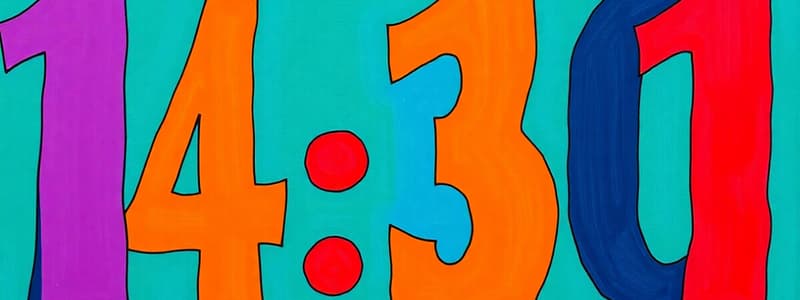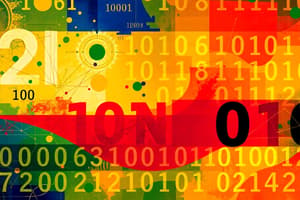Podcast
Questions and Answers
What is the decimal equivalent of the binary number (11011)_2?
What is the decimal equivalent of the binary number (11011)_2?
- 13351
- 27 (correct)
- 2727
- 38
What is the binary equivalent of the decimal number (23)_10?
What is the binary equivalent of the decimal number (23)_10?
- 10111 (correct)
- 11111
- 11000
- 1101
Which of these is a valid binary number?
Which of these is a valid binary number?
- 10010110 (correct)
- 20010110
- 11031011
- 100101102
What is the octal equivalent of the binary number (101101)_2?
What is the octal equivalent of the binary number (101101)_2?
Perform the following binary multiplication: (101)_2 * (11)_2 ?
Perform the following binary multiplication: (101)_2 * (11)_2 ?
What is the decimal equivalent of the octal number (734)_8?
What is the decimal equivalent of the octal number (734)_8?
Which of these binary numbers represents the decimal number (15)_10?
Which of these binary numbers represents the decimal number (15)_10?
What is the hexadecimal equivalent of the decimal number (29)_10?
What is the hexadecimal equivalent of the decimal number (29)_10?
What is the octal representation of the binary number 101101?
What is the octal representation of the binary number 101101?
Which of the following correctly represents the 9's complement of the decimal number 3245?
Which of the following correctly represents the 9's complement of the decimal number 3245?
In the context of binary numbers, what is the 1's complement of 10101?
In the context of binary numbers, what is the 1's complement of 10101?
Why is the octal or hexadecimal representation more desirable for humans when communicating about binary numbers?
Why is the octal or hexadecimal representation more desirable for humans when communicating about binary numbers?
In the context of the 9's complement, what does the expression "10^n - 1" represent?
In the context of the 9's complement, what does the expression "10^n - 1" represent?
What is the main advantage of using complements in digital computers?
What is the main advantage of using complements in digital computers?
What is the relationship between the radix complement and the diminished radix complement?
What is the relationship between the radix complement and the diminished radix complement?
Which of the following BEST describes the goal of using octal or hexadecimal representations for binary numbers?
Which of the following BEST describes the goal of using octal or hexadecimal representations for binary numbers?
What is the binary representation of the decimal number 13?
What is the binary representation of the decimal number 13?
Which of the following numbers is not a valid octal number?
Which of the following numbers is not a valid octal number?
What is the 2's complement of the binary number 1010?
What is the 2's complement of the binary number 1010?
What is the result of the Boolean expression A * B' + C when A = 1, B = 0, and C = 1?
What is the result of the Boolean expression A * B' + C when A = 1, B = 0, and C = 1?
Which of the following is NOT a basic logic gate?
Which of the following is NOT a basic logic gate?
What is the simplified Boolean expression for the expression A'B + AB' + AB?
What is the simplified Boolean expression for the expression A'B + AB' + AB?
Which of the following properties is TRUE for the Boolean AND operation?
Which of the following properties is TRUE for the Boolean AND operation?
In Boolean Algebra, what is the value of 1 + 0?
In Boolean Algebra, what is the value of 1 + 0?
What is the output of a NOT gate when the input is 0?
What is the output of a NOT gate when the input is 0?
Flashcards
Digital Computers
Digital Computers
Computers that process data in binary form.
Binary System
Binary System
A numbering system using only two digits, 0 and 1.
Number Base Conversion
Number Base Conversion
Changing numbers from one base to another (e.g., decimal to binary).
Octal Numbers
Octal Numbers
Signup and view all the flashcards
Hexadecimal Numbers
Hexadecimal Numbers
Signup and view all the flashcards
Boolean Algebra
Boolean Algebra
Signup and view all the flashcards
Logic Gates
Logic Gates
Signup and view all the flashcards
Adders
Adders
Signup and view all the flashcards
Registers
Registers
Signup and view all the flashcards
Synchronous Sequential Logic
Synchronous Sequential Logic
Signup and view all the flashcards
Binary Number System
Binary Number System
Signup and view all the flashcards
Binary Addition
Binary Addition
Signup and view all the flashcards
Binary Subtraction
Binary Subtraction
Signup and view all the flashcards
Binary Multiplication
Binary Multiplication
Signup and view all the flashcards
Base Conversion
Base Conversion
Signup and view all the flashcards
Decimal to Binary Conversion
Decimal to Binary Conversion
Signup and view all the flashcards
Octal Number System
Octal Number System
Signup and view all the flashcards
Example of Decimal to Octal
Example of Decimal to Octal
Signup and view all the flashcards
Octal System
Octal System
Signup and view all the flashcards
Hexadecimal System
Hexadecimal System
Signup and view all the flashcards
9's Complement
9's Complement
Signup and view all the flashcards
1's Complement
1's Complement
Signup and view all the flashcards
Radix Complement
Radix Complement
Signup and view all the flashcards
Diminished Radix Complement
Diminished Radix Complement
Signup and view all the flashcards
Compact Number Representation
Compact Number Representation
Signup and view all the flashcards
Study Notes
Book Title and Author
- Digital Logic and Computer Design
- M. Morris Mano
Contents
- Preface
- Binary Systems (Chapter 1)
- Digital Computers and Digital Systems
- Binary Numbers
- Number Base Conversions
- Octal and Hexadecimal Numbers
- Complements
- Signed Binary Numbers
- Binary Codes
- Binary Storage and Registers
- Binary Logic
- References
- Problems
- Boolean Algebra and Logic Gates (Chapter 2)
- Basic Definitions
- Axiomatic Definition of Boolean Algebra
- Basic Theorems and Properties of Boolean Algebra
- References
- Problems
- Simplification of Boolean Functions (Chapter 3)
- The Map Method
- Two- and Three-Variable Maps
- Four-Variable Map
- Five-Variable Map
- Product of Sums Simplification
- NAND and NOR Implementation
- Other Two-Level Implementations
- Don't-Care Conditions
- The Tabulation Method
- Determination of Prime Implicants
- Selection of Prime Implicants
- Concluding Remarks
- References
- Problems
- Combinational Logic (Chapter 4)
- Introduction
- Design Procedure
- Adders
- Subtractors
- Code Conversion
- Analysis Procedure
- Multilevel NAND Circuits
- Multilevel NOR Circuits
- Exclusive-OR Functions
- References
- Problems
- MSI and PLD Components (Chapter 5)
- Introduction
- Binary Adder and Subtractor
- Decimal Adder
- Magnitude Comparator
- Decoders and Encoders
- Multiplexers
- Read-Only Memory (ROM)
- Programmable Logic Array (PLA)
- Programmable Array Logic (PAL)
- References
- Problems
- Synchronous Sequential Logic (Chapter 6)
- Introduction
- Flip-Flops
- Triggering of Flip-Flops
- Analysis of Clocked Sequential Circuits
- State Reduction and Assignment
- Flip-Flop Excitation Tables
- Design Procedure
- Design of Counters
- References
- Problems
- Registers, Counters, and the Memory Unit (Chapter 7)
- Introduction
- Registers
- Shift Registers
- Ripple Counters
- Synchronous Counters
- Timing Sequences
- Random-Access Memory (RAM)
- Memory Decoding
- Error-Correcting Codes
- References
- Problems
- Algorithmic State Machines (ASM) (Chapter 8)
- Introduction
- ASM Chart
- Timing Considerations
- Control Implementation
- Design with Multiplexers
- PLA Control
- References
- Problems
- Asynchronous Sequential Logic (Chapter 9)
- Introduction
- Analysis Procedure
- Circuits with Latches
- Design Procedure
- Reduction of State and Flow Tables
- Race-Free State Assignment
- Hazards
- Design Example
- References
- Problems
- Digital Integrated Circuits (Chapter 10)
- Introduction
- Special Characteristics
- Bipolar-Transistor Characteristics
- RTL and DTL Circuits
- Transistor-Transistor Logic (TTL)
- Emmitter-Coupled Logic (ECL)
- Metal-Oxide Semiconductor (MOS)
- Complementary MOS (CMOS)
- CMOS Transmission Gate Circuits
- References
- Problems
- Laboratory Experiments (Chapter 11)
- Introduction to Experiments
- Binary and Decimal Numbers
- Digital Logic Gates
- Simplification of Boolean Functions
- Combinational Circuits
- Code Converters
- Design with Multiplexers
- Adders and Subtractors
- Flip-Flops
- Sequential Circuits
- Counters
- Shift Registers
- Serial Addition
- Memory Unit
- Lamp Handball
- Clock-Pulse Generator
- Parallel Adder
- Binary Multiplier
- Asynchronous Sequential Circuits
- Standard Graphic Symbols (Chapter 12)
- Rectangluar-Shape Symbols
- Qualifying Symbols
- Dependency Notation
- Symbols for Combinational Elements
- Symbols for Flip-Flops
- Symbols for Registers
- Symbols for Counters
- Symbol for RAM
- References
- Problems
- Appendix: Answers to Selected Problems
- Index
- Additional Information (Preface)
Studying That Suits You
Use AI to generate personalized quizzes and flashcards to suit your learning preferences.




